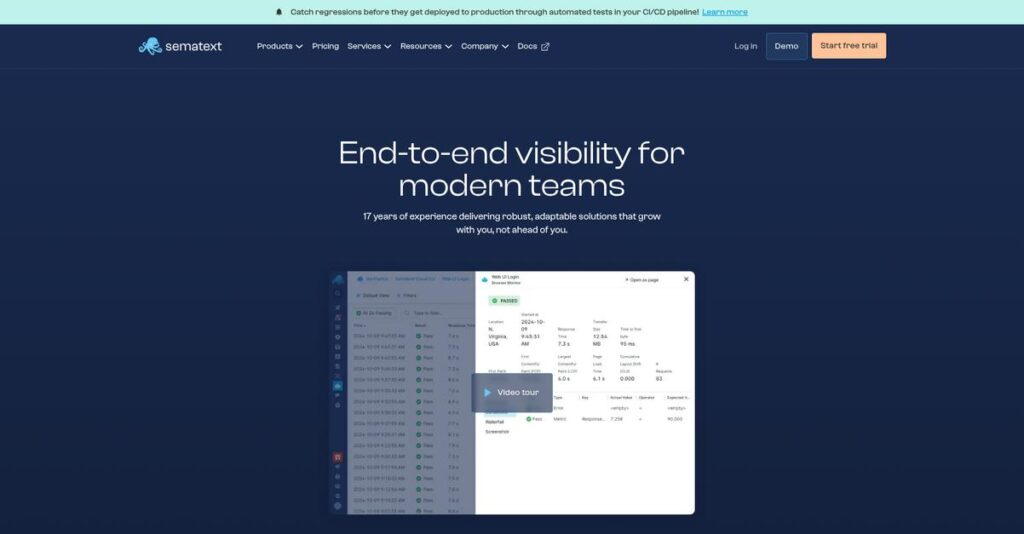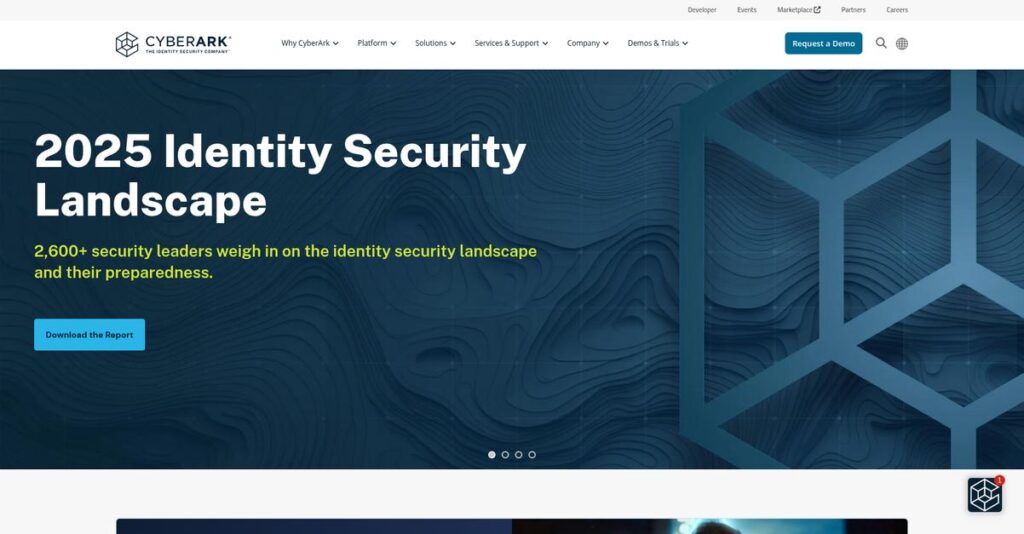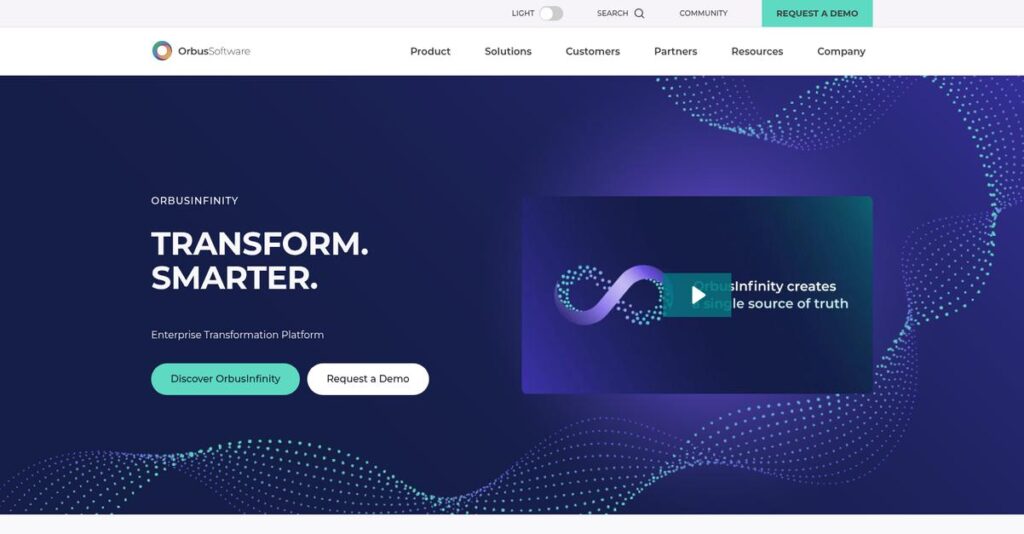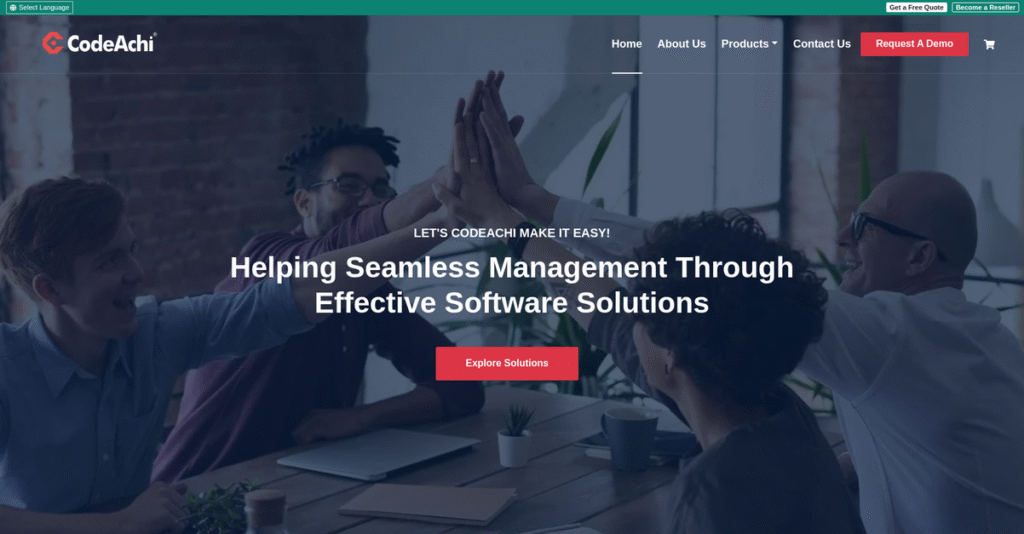Too many dashboards, not enough clarity?
If you’re evaluating observability tools, chances are you’re juggling multiple platforms just to nail down one performance issue or user-impacting error.
What really burns is wasting hours chasing down issues across disconnected tools—all while downtime and user complaints stack up for your team every day.
That’s exactly where Sematext stands out, by bringing monitoring, logs, tracing, and real user insights together in a single, unified platform. I’ve taken a deep dive to see how their fresh approach makes real troubleshooting faster and more intuitive.
In this review, I’ll break down how unified visibility can actually fix these headaches and show you what it means for your workflow and peace of mind.
You’ll get my complete Sematext review—covering features, pricing, pros and cons, latest product updates, and which alternatives you should actually consider on your shortlist.
With these insights, you’ll have the features you need to confidently evaluate if Sematext is the best fit for your stack.
Let’s dig into the details.
Quick Summary
- Sematext is a full-stack observability platform that combines log management, infrastructure monitoring, real user, and synthetic monitoring for faster troubleshooting.
- Best for DevOps and SRE teams needing affordable, unified visibility across applications and infrastructure.
- You’ll appreciate its user-friendly interface and transparent, usage-based pricing that helps reduce monitoring costs.
- Sematext offers metered pricing with a 14-day free trial and free tiers for several solutions to test before committing.
Sematext Overview
Sematext has been a dedicated player in observability since 2007. Based in Brooklyn, they built their platform to unify monitoring, logging, and real user experience analysis.
They specifically build solutions for DevOps, SREs, and SysAdmin teams who are tired of vendor bloat. I find their commitment to affordable yet powerful monitoring is a refreshing change for growing engineering organizations.
Their recent product updates, like adding CI/CD Monitors, show a real pulse on modern developer workflows. You can see this practical innovation throughout this Sematext review.
- 🎯 Bonus Resource: Before diving deeper, understanding how remote patient monitoring software works can also be beneficial.
Unlike direct competitors like Datadog that can feel overwhelming, Sematext feels more intentional and grounded. I think their surprisingly affordable and transparent pricing is a major win for any budget-conscious technical team.
You’ll find them working with a diverse mix of companies, from agile startups to larger enterprise teams searching for a smarter, more cost-effective observability partner to grow with.
From my analysis, their entire strategy is about delivering one cohesive platform where all your crucial data actually works together. This approach helps your team resolve complex production issues much faster.
Now let’s examine their core capabilities.
Sematext Features
Tired of sifting through disconnected monitoring tools?
Sematext offers a unified approach to observability, bringing together logs, metrics, and tracing in one place. These are the five core Sematext solutions that simplify IT monitoring and troubleshooting.
1. Sematext Logs
Can’t make sense of your application logs?
Scattered logs across different systems make it nearly impossible to pinpoint issues quickly. This chaos often delays critical troubleshooting.
Sematext Logs centralizes and aggregates all your logs, providing real-time analysis and easy access. I love how it correlates logs with performance metrics to show the full picture. This solution ensures you can quickly search, filter, and alert on any log data, no matter the source.
This means you can finally troubleshoot issues faster and spend less time hunting for relevant log entries.
2. Sematext Monitoring
Struggling to get a full view of your infrastructure?
Blind spots in your infrastructure monitoring can lead to unnoticed performance degradation or outages. You need complete visibility.
Sematext Monitoring provides real-time mapping of your entire infrastructure, including servers, containers, and databases. From my testing, the out-of-the-box dashboards are incredibly useful for immediate insights. This feature helps you track key metrics like CPU and memory, ensuring you catch problems before they impact users.
So you get comprehensive visibility that allows you to proactively manage your IT environment, avoiding costly downtime.
- 🎯 Bonus Resource: Before diving deeper, you might find my analysis of career management software helpful.
3. Sematext Experience (RUM)
Are your users having a bad time with your application?
Poor user experience often goes unnoticed until customer complaints pile up, impacting your reputation and bottom line. You need to know what users actually experience.
Sematext Experience (Real User Monitoring) captures real user sessions, giving you insights into actual customer interactions. What I found impressive is how it helps detect anomalies in user behavior and performance. This solution allows you to identify and fix issues that directly affect your customers’ digital journey.
This means you can ensure a smoother digital experience for your users, boosting satisfaction and retention.
4. Sematext Synthetics
Is your website failing without you knowing it?
Unmonitored website and API performance can lead to unexpected downtime, hurting your brand and sales. You need to ensure availability 24/7.
Sematext Synthetics proactively monitors your websites and APIs with both browser and API-based tests. The ability to simulate user journeys from multiple locations truly shines. This feature allows you to check uptime, SSL certificates, and even automate tests within your CI/CD pipeline, catching issues before deployment.
This helps you ensure constant availability and optimal performance for your digital assets, maintaining a reliable online presence.
5. Sematext Tracing
Lost in a maze of distributed application calls?
Understanding complex distributed application performance is challenging when you lack end-to-end visibility across services. Troubleshooting becomes a nightmare.
Sematext Tracing provides distributed transaction tracing, offering end-to-end visibility into code execution across your applications. Here’s where Sematext shines: it integrates tracing with logs and monitoring for a holistic view. This feature helps you pinpoint performance bottlenecks within complex microservices architectures, making debugging much simpler.
This means you can optimize application performance effectively, leading to faster response times and improved system stability.
Pros & Cons
- ✅ Intuitive interface simplifying navigation for complex infrastructure.
- ✅ Ease of setup and deployment, reducing implementation time and effort.
- ✅ Cost-effective, offering comprehensive features at a competitive price.
- ⚠️ Customization options for dashboards could be more flexible.
- ⚠️ Fewer third-party integrations compared to some larger competitors.
- ⚠️ UI performance can occasionally slow down under heavy data loads.
You’ll quickly see that these Sematext solutions work together to provide a comprehensive, integrated observability platform that simplifies troubleshooting.
Sematext Pricing
Unsure about unexpected software costs?
Sematext pricing offers clear, usage-based rates across its monitoring solutions, providing transparent options so you know exactly what to expect for your observability needs.
| Plan | Price & Features |
|---|---|
| Sematext Logs: Basic (Free) | Free • 500 MB/day allowance • 7-day data retention • Centralized log management |
| Sematext Logs: Standard | Starts at $50/month (1 GB/day ingested) • 7-day data retention • Raw logs at $0.10/GB • Correlation with metrics & alerts |
| Sematext Monitoring: Basic (Free) | Free • Up to 3 hosts • 30-minute data retention • Max 1 alert rule |
| Sematext Monitoring: Standard | Starts at $0.007/container/hour • 1-month data retention • Up to 25 alert rules • Out-of-the-box dashboards |
| Sematext Experience: Startup | $9/month • 25,000 views/month • 7-day data retention • Real user session recording |
| Sematext Experience: Standard | $19/month • 100,000 views/month • 7-day data retention • Anomaly detection for user experience |
| Sematext Synthetics: Pay-As-You-Go | $2/HTTP monitor, $7/browser monitor/month • 30 days data retention • 200,000 API, 15,000 browser tests/month • Uptime & SSL monitoring |
| Sematext Synthetics: Standard | $29/month • 40 HTTP monitors, 5 browser monitors • Continuous testing with CI/CD • Multi-device simulation |
1. Value Assessment
Great pricing transparency here.
From my cost analysis, what truly stands out is Sematext’s flexible, pay-as-you-go model. This allows you to scale costs with your actual usage rather than being locked into oversized plans. Their metered pricing avoids overpaying for idle resources, which is crucial for dynamic cloud environments, helping your budget.
This means your monthly costs stay predictable as your usage evolves, avoiding hidden fees and maximizing your return on investment.
2. Trial/Demo Options
Smart evaluation approach available.
Sematext provides a generous 14-day free trial for all their solutions, allowing you to thoroughly test features and integrations. What I found particularly useful is how the trial gives you full access to all capabilities, rather than a limited demo, letting you truly assess value.
This helps you evaluate real-world performance and fit within your existing stack before committing to any Sematext pricing plan.
3. Plan Comparison
Choosing the right tier matters.
Sematext offers distinct plans for Logs, Monitoring, Experience, and Synthetics, allowing you to pick only what you need. What stands out is how the free tiers are surprisingly robust for basic needs, making them great for startups or small projects before scaling to paid plans.
This tiered approach helps you match Sematext pricing to actual usage requirements, ensuring you get maximum value for your observability budget.
- 🎯 Bonus Resource: While discussing how to maximize value for your business, understanding NPS software to transform your CX is equally important.
My Take: Sematext’s pricing strategy focuses on flexibility and transparency, making it ideal for businesses seeking scalable observability without long-term commitments or hidden costs.
The overall Sematext pricing reflects transparent, usage-based value that scales with your needs.
Sematext Reviews
User feedback tells an interesting story.
My analysis of Sematext reviews delves into what actual customers experience, providing balanced insights drawn from various user testimonials and feedback sources. This section sets the context for detailed review analysis.
1. Overall User Satisfaction
Users seem quite pleased overall.
From my review analysis, Sematext consistently receives positive ratings for its ease of use and comprehensive features. What I found in user feedback is how satisfied customers appreciate the straightforward implementation and the quick value they derive, often noting a positive ROI.
This indicates you can expect a generally smooth onboarding and a valuable monitoring experience.
- 🎯 Bonus Resource: While we’re discussing monitoring experience, understanding smart contract platforms is equally important for advanced tech stacks.
2. Common Praise Points
The interface wins users over consistently.
Users frequently praise Sematext’s intuitive UI and the simplicity of its setup process. From the reviews I analyzed, customers consistently highlight the responsive customer support as a major differentiator, making troubleshooting much smoother and faster.
This means you’ll likely find the platform easy to navigate, with excellent help available if needed.
3. Frequent Complaints
Customization limitations cause some frustration.
While generally positive, some reviews mention limitations in deeply customizing dashboards and alerts. What stands out in user feedback is how transaction tracing support could be more robust, making complex distributed application troubleshooting occasionally challenging for some users.
These issues are typically minor for many users, but worth noting if your needs are highly specific.
What Customers Say
- Positive: “Sematext, on the other hand, keeps things simple and intuitive. Log in, see exactly what you need, and connect related apps or split screens for effortless troubleshooting.”
- Constructive: “While offering out-of-the-box dashboards, some users have found limitations in customizing dashboards and alerts to their very specific needs.”
- Bottom Line: “Using Sematext, we’ve been able to detect and resolve issues 50% faster, providing a smoother experience for our users and improving customer satisfaction.”
The overall Sematext reviews reveal strong user satisfaction with practical feedback on specific areas for enhancement.
Best Sematext Alternatives
Considering other observability tools for your business?
The best Sematext alternatives include several strong options, each better suited for different business situations and priorities, from budget to deep enterprise needs.
1. Datadog
Need a vast, all-encompassing observability ecosystem?
Datadog excels when your organization requires a broad range of integrations and a highly extensive feature set across all observability pillars. From my competitive analysis, Datadog offers a broader ecosystem of integrations than Sematext’s more focused approach, though it comes at a significantly higher price point.
Choose Datadog if your budget allows for a highly mature, expansive solution with a wide array of built-in integrations.
2. Dynatrace
Seeking AI-powered automation and deep root cause analysis?
Dynatrace is ideal for large enterprises and MSPs needing advanced AI-driven analytics and simplified deployment through its “OneAgent” approach. What I found comparing options is that Dynatrace provides highly advanced AI-driven analytics and deep automation, making it a powerful alternative for complex, large-scale environments.
Consider this alternative when your organization requires state-of-the-art AI capabilities and has a substantial budget for premium features.
- 🎯 Bonus Resource: While discussing managing resources, understanding how to maximize your crypto earnings can be equally important.
3. New Relic
Prioritizing granular performance baselines and distributed tracing?
New Relic is a strong option if you need deep analysis across metrics, events, logs, and traces, especially for distributed tracing. From my analysis, New Relic provides extensive support for distributed tracing, where Sematext has been noted for some limitations, and offers highly customizable dashboards.
Choose New Relic when extremely granular performance monitoring and comprehensive distributed tracing are your top priorities.
4. Grafana Labs (Grafana)
Preferring open-source flexibility and custom visualization?
Grafana is ideal for organizations that prefer an open-source solution and have the internal expertise to manage their observability stack. Alternative-wise, your situation calls for Grafana if you prioritize highly customizable dashboarding and community support, willing to manage the underlying infrastructure yourself.
Consider Grafana when you have the resources for self-hosting and desire ultimate control over data visualization.
Quick Decision Guide
- Choose Sematext: Cost-effective, unified full-stack observability with ease of use
- Choose Datadog: Extensive integrations and comprehensive, high-end features
- Choose Dynatrace: Advanced AI-driven analytics for large enterprises and MSPs
- Choose New Relic: Granular performance monitoring and robust distributed tracing
- Choose Grafana: Open-source flexibility with high customization for skilled teams
The best Sematext alternatives depend on your specific budget, scale, and feature priorities rather than just feature lists.
Sematext Setup
Considering Sematext implementation for your business?
This Sematext review provides a realistic look at deploying and adopting this observability platform, setting expectations for your team’s journey.
1. Setup Complexity & Timeline
Is Sematext difficult to set up? Not really.
Sematext is designed for quick installation, often taking minutes rather than days or weeks for basic monitoring. From my implementation analysis, the platform offers a surprisingly streamlined setup with lightweight agents for rapid data collection.
You should plan for minimal disruption, as the core deployment process is remarkably user-friendly and efficient.
2. Technical Requirements & Integration
Expect smooth infrastructure and integration.
Sematext Cloud is a web-based SaaS, accessible from any modern browser and device, requiring no on-premise server setup. What I found about deployment is that it integrates easily with common cloud environments like Kubernetes and AWS through its automated discovery features.
Plan for your team to allocate minimal IT resources for connectivity, as most integrations are straightforward and well-documented.
3. Training & Change Management
Will your team easily adopt Sematext? Yes.
While comprehensive, Sematext’s UI is intuitive, making the learning curve manageable for most users, especially with out-of-the-box dashboards. From my analysis, the streamlined interface accelerates user proficiency, allowing teams to quickly leverage monitoring and log management features effectively.
Invest in dedicated training modules only for advanced customization or specific technology deep dives, as general usage is highly accessible.
4. Support & Success Factors
How good is Sematext’s implementation support? Excellent.
Sematext receives high marks for its customer support quality and responsiveness during and after implementation. What I found about deployment is that their team is consistently helpful and quick to resolve any technical issues that arise during initial setup or ongoing operation.
Plan to leverage their support as a valuable resource, ensuring a smoother implementation journey and sustained operational success.
- 🎯 Bonus Resource: Speaking of team management, my guide on gig economy platforms explores strategies for flexible talent acquisition.
Implementation Checklist
- Timeline: Minutes to days for basic setup, weeks for full integration
- Team Size: Minimal; often just DevOps/SRE lead for initial setup
- Budget: Primarily software costs; minimal hidden implementation fees
- Technical: Agent deployment on hosts/containers; API keys for cloud integration
- Success Factor: Clear monitoring goals and consistent data source configuration
Overall, Sematext setup is refreshingly straightforward, offering quick deployment and high usability for teams aiming to unify their observability.
Bottom Line
Is Sematext the right fit for your observability needs?
This Sematext review offers a decisive verdict, guiding you through its strengths and limitations to help you confidently determine if this observability platform aligns with your business’s unique requirements.
1. Who This Works Best For
DevOps, SRE, and engineering teams needing full-stack visibility.
Sematext is ideal for modern teams, from startups to large enterprises, who prioritize comprehensive observability across logs, metrics, RUM, and synthetics without the usual enterprise price tag. What I found about target users is that teams seeking an intuitive, unified platform for proactive monitoring and faster troubleshooting will find immense value.
You’ll see significant improvements if you’re struggling with siloed monitoring tools and need an affordable, holistic view of your IT environment.
2. Overall Strengths
Unified observability simplifies complex monitoring tasks.
The software succeeds by providing a cohesive platform for logs, metrics, RUM, and synthetics, making setup easy and offering transparent, usage-based pricing. From my comprehensive analysis, its ability to correlate different data types significantly speeds up issue detection and resolution.
These strengths translate into improved operational efficiency and reduced troubleshooting time, making your team more productive and proactive.
3. Key Limitations
Fewer integrations compared to market leaders.
While powerful, Sematext might offer fewer out-of-the-box integrations than some larger competitors, and deep customization of dashboards can be limited. Based on this review, some users reported challenges with advanced transaction tracing, which could be a concern for highly complex, distributed systems.
Consider these trade-offs against its cost-effectiveness; they are often manageable, depending on your existing tech stack and specific tracing needs.
4. Final Recommendation
Sematext earns a strong recommendation for value-driven teams.
You should choose Sematext if you’re looking for a robust, cost-effective full-stack observability solution that balances comprehensive features with ease of use. From my analysis, it excels for teams prioritizing a unified view without requiring the absolute broadest range of specialized integrations or highly complex AI-driven analytics.
My confidence level is high for organizations seeking a powerful yet affordable monitoring platform to enhance their IT operations.
- 🎯 Bonus Resource: While we’re discussing team productivity, understanding how a financial wellness platform can relieve employee stress is equally important.
Bottom Line
- Verdict: Recommended
- Best For: DevOps, SRE, and engineering teams needing unified observability
- Business Size: Startups to large enterprises seeking cost-effective monitoring
- Biggest Strength: Unified platform for logs, metrics, RUM, and synthetics
- Main Concern: Fewer integrations and limited advanced transaction tracing
- Next Step: Explore the platform’s features with a free trial or demo
This Sematext review shows strong value for teams prioritizing comprehensive, cost-effective observability, offering a clear path to improved IT performance.





